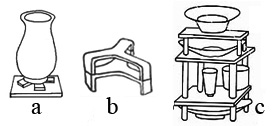PACKING (c) Decorated work
ca: CARREGAR (c) Peces decorades
es: CARGAR (c) Piezas decoradas
Packing decorated work: Great care must be taken so that the kiln and the work being fired are not damaged in any way. Slip and glazes must not touch anything, each other, the walls of the kiln, the floor or shelves, furniture, etc. when being fired. All the parts or the footings which they stand on must be cleaned of glaze, since it acts as a glue and when fired will weld on to any object it touches and make it impossible to separate without damaging the work. Read more about: Kiln – Furniture
 Packing Plates
Packing Plates
a) Packing – with the danger of glaze running:
Should there be any danger of a glaze or color running, put the vessel on top of 3 or 4 bits and put these on a bisque tile. The tile will stop the floor of your kiln being damaged and if the glaze runs into the space made by the bits, will make it easier to twist and separate the pieces.
b) Plate supports: There are many types of cranks for plates and tiles, these are good if the plates and tiles you wish to fire are made with molds and therefore all the same size, but if handmade and varying in size, they are more difficult to fit in.
c) Tile shelves take up more room but are quicker and safer. They are made up with bisque tiles cut to the required sizes and are supported by tube props. Stilts and spurs can be used, but as putting them on top or under a plate always damages the glaze, the work will have to be repaired and repaired work is never perfect.
 Packing Pots and Lids When decorated it is difficultto to move them without touching and damaging the decoration, some lids are designed so the flange is high enough to put your fingers under the lip to move them. If picked up and a part that is decorated is touched it will have to be repaired when it is in the kiln.
Packing Pots and Lids When decorated it is difficultto to move them without touching and damaging the decoration, some lids are designed so the flange is high enough to put your fingers under the lip to move them. If picked up and a part that is decorated is touched it will have to be repaired when it is in the kiln.
d) The best way is to put the pots and the lids on top of a bisque tile that has been cut down to the size needed; it can be moved, using the tile like a tray and does not have to be touched throughout the whole process, from decorating on the wheel to putting the tile into the kiln as a tile shelf.
e) Pots can be moved by putting your hand inside the neck and using the pressure of your finger against the inside of the neck to lift and move them.
f) Lids, as they are short can be built up one top of the other, using tile shelves with tube prop, to support them.
Packing Tiles
 Tile stands also known as cranks, the illustration shows two types of tile stands.
Tile stands also known as cranks, the illustration shows two types of tile stands.
g) is dismountable.
h) is in one piece. For kilns that open at the side both can be used but for those that open at the top, the second is more convenient as it can be lifted up and put down into the kiln.
A big problem with tile stands is fitting them into your kiln without wasting space. Make sure when you buy a kiln that there is enough room to stand one on top of another. One of the disadvantages of standsnts for different sized tiles is that they are of different heights and this makes building up floors complicated. Kilns that open at the top have to be packed from above, so the large tile stands must be made in one piece. They have to be held at the top and lowered into the kiln. If your kiln opens from the front, other types of stands can be used. If you work with tiles a lot, you should have numerous stands, so when you have finished painting, the tiles can put directly into them, thus avoiding the damage that occurs when moving them from one place to another. The less you touch and move your finished work, the better.
 i) Small separate wall-stands: These are handmade to hold from two to four tiles of any size. They are short because they are separate and have to be held together securely when being moved. They are used mainly for packing borders 7,5 × 15cm, corners 7,5 × 7,5cm, and to fill up the leftover spaces when packing. In the section on molds, how to make them is explained.
i) Small separate wall-stands: These are handmade to hold from two to four tiles of any size. They are short because they are separate and have to be held together securely when being moved. They are used mainly for packing borders 7,5 × 15cm, corners 7,5 × 7,5cm, and to fill up the leftover spaces when packing. In the section on molds, how to make them is explained.
Read more about: Cranks / Cranks – Putting tiles in cranks / Cranks – Walls / Mold: 5 Hand made cranks
